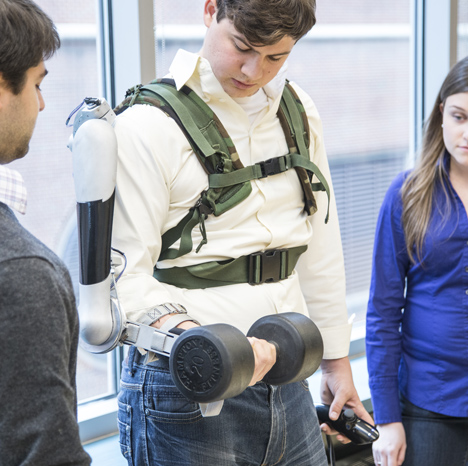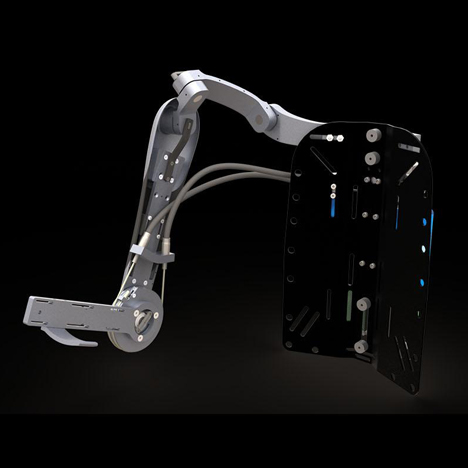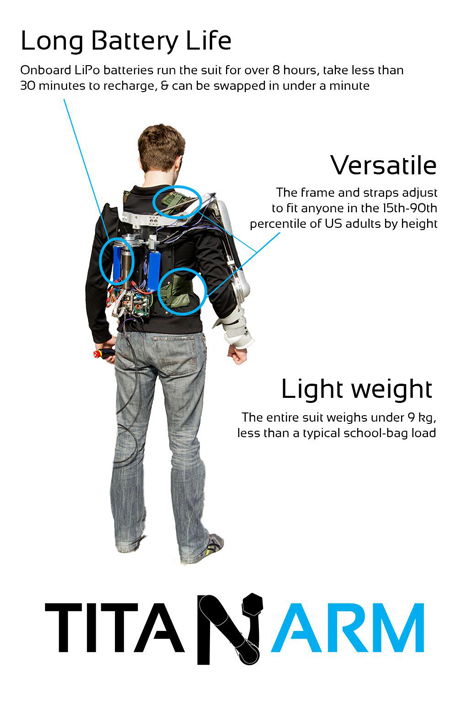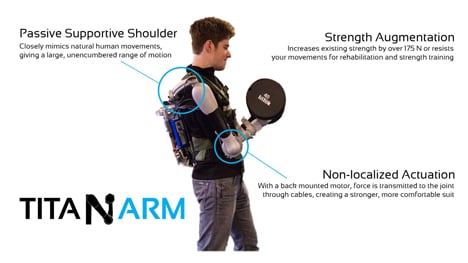Strap-on robotic Titan Arm wins £30,000 Dyson award
News: a strap-on robotic arm that allows humans to lift heavy weights has won this year's James Dyson Award for the most innovative student design product.

Titan Arm, an "upper body exoskeleton" developed by students at the University of Pennsylvania, won the £30,000 prize, which is given annually to the best design or engineering project by a student or recent graduate.
"Titan Arm is obviously an ingenious design, but the team’s use of modern, rapid – and relatively inexpensive – manufacturing techniques makes the project even more compelling," said James Dyson, founder of electrical appliance brand Dyson and head of the James Dyson Foundation, which organises the James Dyson Award.

The arm allows the user to lift an additional 18 kilos and is designed to reduce the incidents of back injuries caused by heavy lifting, and allow people with injuries to rebuild and retrain their muscles.
Weighing around 9kg and worn like a backpack, the arm is powered by an on-board battery and uses cables to control a robotic elbow joint.
"The suit was developed for use in occupational lifting and healthcare," the Titan Arm team explain. "Occupational lifters such as warehouse workers face increased risk of arm and back injuries because they repeatedly lift heavy items every day."

The arm cost just $2,000 to develop, compared to more than $100,000 for other commercially available arms. The low cost was achieved by using accessible technologies such as 3D printing. The team plan to make the design available as an open-source file so others can improve and learn from it.
According to the Titan Arm team, upper-body injuries cause 7,000 years of lost productivity among American workers alone, costing $50 billion in healthcare costs.

"We all know someone who has suffered a back or arm injury and worked hard to recover, or live with permanent damage," say the project team. "We are passionate about developing a tool that allows people to live normally, by both preventing injuries and lessening their effects."
Titan Arm plans to use the cash prize to investigate electromyography, which would allow sensors in the arm to record electrical activity in the user's muscles. This would allow the arm to interpret and amplify the user's intentions, effectively making it a seamless extension of their body.
"This, if incorporated into Titan Arm, could allow people with severe injuries or suffering from paralysis to be abler to command their arms utilising the electrical activities in their muscles," said the James Dyson Award. "Potentially giving them the ability to move their arms with the devices help, only using their brain."
Last year's James Dyson award was won by Royal College of Art graduate Dan Watson, for a sustainable fishing net that allows young fish to escape.
Here's some text about Titan Arm:
Function
Titan is an upper-body exoskeleton that augments human strength and provides rich data feedback for users and doctors. The suit was developed for use in occupational lifting and healthcare. Occupational lifters such as warehouse workers face increased risk of arm and back injuries because they repeatedly lift heavy items every day. To prevent this, Titan augments the user’s arm strength by 18 kg to reduce fatigue, and braces the back to prevent poor lifting posture. Healthcare applications include physical therapy and mobility assistance. Titan can be used to help stroke and injury victims rebuild muscle and relearn fine motor control. It also provides detailed quantitative feedback to doctors which can be used to motivate their patients by tracking improvement over time. Finally, Titan can help people who suffer from permanent injuries or disabilities to live fully-empowered lives. Using an exoskeleton, both patients and the elderly will be able to regain their independence.
Inspiration
We all know someone who has suffered a back or arm injury and worked hard to recover, or live with permanent damage. As a team, we are passionate about developing a tool that allows people to live normally, by both preventing injuries and lessening their effects. We became even more motivated as we met therapists and patients working through these hardships. Each story showed how demoralizing upper body injuries can be. We hope that Titan will empower people to reclaim their lives. We are determined to make the field more accessible. Current exoskeletons are prohibitively expensive at more than $100,000. Using lean principles, we created Titan for less than $2,000. Low price points will help make Titan ubiquitous, aiding many more people. We will also release a version of Titan as an open-source development platform for researchers to experiment and collaborate on. Through this, we hope to enable a new era of research, resulting in innovative devices to improve lives.
Development
As a team of four mechanical engineering students, we developed Titan over eight months. We researched available exoskeletons and past academic projects, and decided to focus on the upper body, as most exoskeletons have aided the legs. We then completed technical and market research, talked to physical therapists, and met with patients. Using this information, we designed the mechanical, electrical, and control systems for the exoskeleton. Using CAD software coupled with techniques such as 3D printing and CNC machining, we produced several physical prototypes, leading us to Titan’s ergonomic form. We sourced and soldered the electrical components, striving for computational power and efficiency. Meanwhile we developed custom software to control the suit and transmit data in real-time to therapists. We continued talking to experts so that we could remain focused on their needs and our use cases. Finally we integrated the various systems to produce a functioning, wearable prototype.